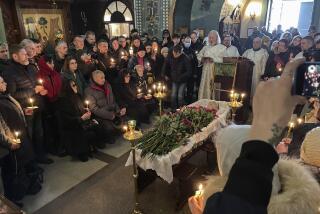Lack of State Rite Prompts Criticism by Some : Gromyko Buried in Low-Key Ceremony
- Share via
MOSCOW — Tens of thousands of Soviets filed past the body of former Foreign Minister Andrei A. Gromyko in the capital’s dimly lit Red Banner Hall on Wednesday before the official who personified the Soviet Union to the West for nearly three decades was buried in a private ceremony.
A giant photograph of the forbidding-looking Gromyko framed in red adorned the front of the Central Soviet Army Building, where the body lay in state on the second-floor hall in an elevated, open coffin.
Displayed in front of the body on red cushions were 36 medals that Gromyko had been awarded for his service to the state, including six Order of Lenin medals, the highest civilian award.
But he was not given the sort of farewell that some thought was his due.
No Place of Honor
Gromyko, who died Sunday at the age of 79, was buried in the Novodevichy Cemetery and not, as is common for an official of his standing, cremated and given a place of honor in the Kremlin walls. He was buried next to the grave of Elizaveta A. Suslov, the wife of longtime Kremlin ideology chief Mikhail A. Suslov. Soviet officials initially said he would be buried in a state ceremony but later said it would be private.
That angered some of those who joined a line that stretched for two miles around Kommuni Square to see the body.
“It makes me mad that Gromyko will not be buried in the Kremlin Wall. We must have more respect for someone who was in our leadership for so long,” said 74-year-old Gina S. Peisachenko. “I cannot understand it unless it was Gromyko’s own wish.”
The Supreme Soviet continued its work as normal despite the funeral, and President Mikhail S. Gorbachev, who had announced Gromyko’s death on Monday to the legislature, had proceeded with plans to travel to Paris on an two-day official visit that began Tuesday.
Vitaly I. Vorotnikov, the premier of the Russian Federation and a member of the ruling Politburo, was the highest-ranking official to attend the 15-minute burial ceremony at Novedevichy, the country’s second most prestigious resting place.
“I think Gorbachev should have been here for the funeral,” said Alexander V. Odinokov, a 19-year-old Moscow University engineering student who waited in line in a suit and tie to pay his respects. “Gromyko was not so important when he died, but in his own time, he was a great leader.”
Gromyko served for 28 years as foreign minister after having been ambassador to the United States, the United Nations and Britain. Before that he had helped found the United Nations and forge the alliance with the West during World War II.
But to the West, Gromyko often presented a confrontational face, earning him the nicknames “Mr. Nyet” and “Grim Grom.” After Gorbachev became Communist Party leader in March, 1985, he shifted Gromyko to the then-largely ceremonial post of president in an apparent effort to improve and revitalize Soviet foreign relations. Gromyko was retired last October when Gorbachev assumed the presidency.
In addition to his sometimes quarrelsome manner as foreign minister, Gromyko also was criticized for being in charge of the country’s foreign policy when the decision was made to send Soviet troops into Afghanistan, a move that the army itself has now called a mistake.
A Very Difficult Time’
“He was leading and working during a very difficult time in our history,” longtime Soviet ambassador to Washington Anatoly F. Dobrynin, now an adviser to Gorbachev, told reporters at the Central Soviet Army Building as he arrived to pay his respects. “He did his best.”
Inside Red Banner Hall, black fabric was draped over mirrors and chandeliers in keeping with Soviet tradition, and a dozen militiamen kept the crowds moving quickly past the body.
Gromyko’s widow, Lydia, dressed in black and wearing a black scarf, sat to the left of the coffin, greeting Soviet officials and foreign diplomats who came to offer condolences. On either side of her sat their children, Anatoly and Emilia.
Militiamen in the hall estimated that about 50,000 people waited in line during the gray, damp day to file past Gromyko’s body during the five hours it was on display.
Soviet media have said only that Gromyko died after “a long, difficult illness.” A Soviet official said privately Wednesday that Gromyko had been hospitalized for three weeks at the time of his death and died when his aorta, the heart’s main artery, burst.
Marina Salyakhetdinov, 30, brought her 11-year-old daughter Natalya to see Gromyko’s body.
“I wanted her to know about him,” Salyakhetdinov said. “But I am curious because they are not burying him in the Kremlin Wall and because Gorbachev is not here for the funeral. Perhaps, as seems to have become the custom, we will be hearing criticism of him now that he is dead.”
More to Read
Sign up for Essential California
The most important California stories and recommendations in your inbox every morning.
You may occasionally receive promotional content from the Los Angeles Times.













